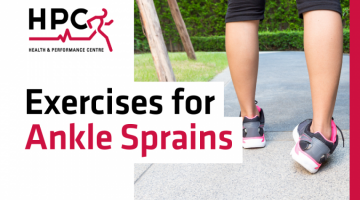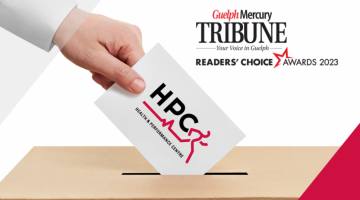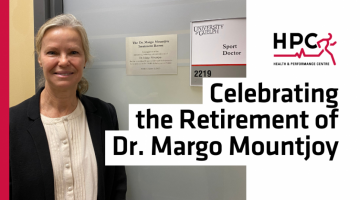Knee Pain? Physiotherapy Can Help!

Knees play a vital role in our mobility, enabling us to perform daily activities with ease. Understanding how the knee works and knowing effective ways to strengthen the knee and surrounding muscles can help prevent injuries and maintain optimal knee health. In this article, the Health and Performance Centre (HPC), a leading physiotherapy clinic in Guelph, provides valuable insights into knee anatomy, exercises for strengthening the knees, common knee problems, and treatment options.
Basic Knee Anatomy
The knee joint consists of the femur, tibia, fibula, and patella, all working together to provide stability and flexibility. The lower limb muscles, including the quadriceps femoris, hamstrings, adductors, and glute muscles, are responsible for knee movement and support.
- The lower limb is made up of the femur, the tibia, and the fibula, as well as the patella (better known as the kneecap!).
- The muscles of the lower limb allow us to flex and extend our knee (a hinge joint) as well as abduct and adduct our leg through the hip joint (ball and socket joint).
- The quadriceps femoris muscle group consists of the vastus medialis, vastus intermedius, vastus lateralis, and rectus femoris.
- The hamstring muscle group consists of the biceps femoris, semitendinosus, and semimembranosus.
- The adductors consist of the adductor longus, adductor brevis, adductor magnus, gracilis, and pectineus.
- The main three glute muscles are the gluteus maximus, gluteus medius, and gluteus minimus. There are smaller muscles underneath these, such as the piriformis muscle.
Exercises for Strengthening your Knees:
To strengthen the muscles surrounding your knees and minimize the risk of injuries, the Guelph physiotherapy team at HPC recommends the following exercises. Remember, you can add weights gradually to enhance strength and muscle growth.
- Squats: 15 reps x 3 sets
- Lunges: 15 reps x 3 sets
- Calf raises: 25 reps x 3 sets
- Standing hamstring curls: 15 reps x 3 sets, repeat for each leg
- Step-ups: 10 reps x 3 sets, repeat for each leg
- Side leg raises: 15 reps x 3 sets, repeat for each leg
Note: Cease any exercise if you experience pain. For proper guidance, consult our trained Guelph physiotherapists here at the Health and Performance Centre.
Common Knee Problems:
Understanding common knee problems can help you identify potential issues and seek appropriate treatment in a timely manner. Here are some knee problems that individuals often encounter:
- Meniscus/Cartilage Tears: These tears occur due to twisting the knee with the foot planted, squatting, or kneeling. Seek immediate medical attention if you suspect a tear. READ MORE
- Sprains or Strained Ligaments and/or Muscles: Overstretching or sudden movements can cause ligament or muscle sprains. Rest, ice, compression, and elevation (RICE) can help alleviate symptoms.
- Arthritis: Knee arthritis can lead to pain, stiffness, and reduced range of motion. Consult a healthcare professional for diagnosis and treatment options.
- Osteoarthritis: This progressive condition involves the loss of articular cartilage, resulting in bone-on-bone contact. Seeking medical advice can help manage symptoms and slow down progression.her.
- Tendonitis and Tendinopathy: Inflammation of tendons around the knee can cause pain and discomfort. Rest, physiotherapy, and proper rehabilitation can aid in recovery.
- Pes Anserinus Tendinopathy: Pes Anserinus Tendinopathy: This condition involves inflammation of the bursa associated with the pes anserinus. Seek professional help for appropriate management. READ MORE
- Knee replacements: Severe knee damage may require surgical intervention, such as knee replacements. Consult an orthopedic specialist to explore treatment options.
- Shin splints: Though commonly associated with running, shin splints can also result from excessive stress on the knee. Rest, ice, and physiotherapy are often recommended.
- Dislocations: Knee dislocations occur when the bones in the joint are forced out of their normal position. Seek immediate medical assistance in such cases.
- Osgood-Schlatter Disease: Involves inflammation just below the knee where a bony structure called the tibial tubercle covers the growth plate in the shinbone (the tibia). It is usually caused by rapid growth spurts when muscles, bones and tendons are changing quickly.
Knee Pain Treatments:
When experiencing knee pain or discomfort, seeking professional treatment is crucial. At the Health and Performance Centre, we offer a range of treatments tailored to each individual's needs:
- Exercise and Strengthening: Targeted exercises and strengthening programs can improve knee stability and function.
- Physiotherapy: Skilled physiotherapists can assess and treat knee pain using a variety of techniques, including manual therapy and rehabilitation exercises.
- Massage Therapy: Massage therapy can help alleviate muscle tension, improve circulation, and promote overall relaxation.
- Combination of Physical Therapy Tools: Advanced physical therapy tools, such as ultrasound therapy, electrical stimulation, or laser therapy, may be used as part of a comprehensive treatment plan.
- Medication: In certain cases, medications such as pain relievers or anti-inflammatory drugs may be prescribed to manage knee pain and reduce inflammation.
Maintaining healthy knees is essential for maintaining an active lifestyle. By understanding the basic knee anatomy, engaging in targeted exercises, and seeking appropriate treatment for knee problems, you can enhance knee strength, prevent injuries, and improve overall mobility. For personalized guidance and expert care, book an appointment with the Health and Performance Centre, your trusted physiotherapy clinic in Guelph.
Note: This article is for informational purposes only and should not replace professional medical advice. Please consult a healthcare professional for diagnosis and treatment of specific knee conditions.




